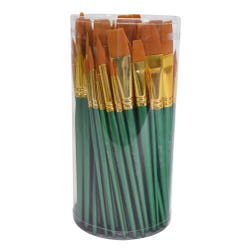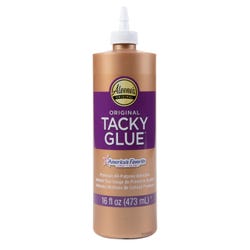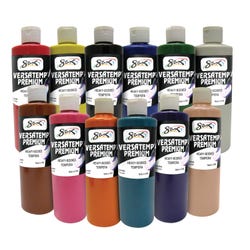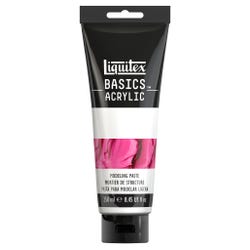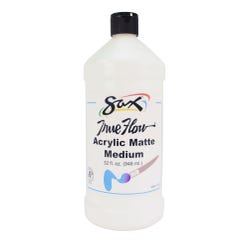Colorful Collage

Description
Lesson Plan and Artwork by Phyllis M. Annett
Sax Versatemp Premium Tempera Paint, is chosen for this collage lesson because of its vibrant pigment and full bodied consistency. Students will review and experience the Art of Collage, Color Theory and the Elements and Principals of Art and Design. Sax Versatemp Premium on watercolor paper, over a canvas panel subtrate, will be utilized to create components for a ‘Colorful Collage’ that illustrates the visual effects of color. Specific tools and techniques will be used to imprint texture on to the collage pieces.
Objectives
- Study and experience the art of collage and its place in history.
- Produce collages that show various color schemes enhanced with textural effects.
- Conclude that collage is in a constant state of metamorphosis, both creative and non-intimidating.
Supplies Needed
Sax® Versatemp® Premium Heavy-Bodied Tempera, Assorted Colors, Pints, Set of 12
Sax® Genuine Canvas Panel, 12 x 16 in, White
Sax® Optimum Golden Synthetic Taklon Paint Brushes, Assorted Sizes, Set of 72
Sax® True Flow® Acrylic Medium, Quart, Matte
Roylco® Funny Floppy Foam Paint Brushes, Set of 6
Fabriano® Watercolor Cold Press Pad, 11 x 14 in, 140 lb ,12 sheets
Aleene’s® Original Tacky Glue®, Pint, Dries Clear
Liquitex® BASICS® Modeling Paste, 8.45 oz.
Jack Richeson™ Plastic Flexible Super Safety Painting Knife, Set of 5
Arcor Soft Copper Wire, 14 Gauge, 80 ft, 1 lb Spool
Standards
Standard #1: Generate and conceptualize artistic ideas and work.
Standard #3: Refine and complete artistic work.
Standard #5: Develop and refine artistic work for presentation.
Standard #7: Perceive and analyze artistic work.
Standard #9: Apply criteria to evaluate artistic work.
Standard #11: Relate artistic ideas and works with societal, cultural and historical context to deepen understanding.
Instructions
1
Present the lesson by: Reviewing Color Theory and the Elements and Principles of Art and Design. Inform students that they will produce a collage painted in tempera on watercolor paper, using a canvas board for the substrate. Students will use a combination of drawing, painting, cutting and gluing techniques to form the collage. The work will highlight color and texture.
2
From the French word ‘coller’, to glue, the art of collage came to the forefront of the art world in Paris during the 20th century by Pablo Picasso and Georges Braque. It can also be found in the work of Andre Breton from the Dada period in the 1920’s.
3
Show prints and computer images from artists that illustrate collage as an art form.
4
Reviewing color theory will lead students to consider color combinations for their work. ie: Primary, Secondary and Tertiary, Complimentary or Analogous for various parts of the collage. Post a color wheel for reference.
5
Possible themes to consider are: Imaginary creatures, bontanical studies, planetary landscapes, animals, birds, insects, vehicles, abstract free forms or landscapes of any kind.
6
Distribute paint, brushes, palette knives, modeling paste and foam brushes and a heavy weight paper for students to practice color mixing, layering of paint and textural effects with tools. Demonstate and work along with students while they are color mixing and experimenting with texture tools. Help them decide on color schemes for the main subject and background. Students can make their own ‘Color Wheels’ to further understand Color Theory.
7
Demonstrate and direct students to form their ‘Colorful Collage’ in the following steps.
8
Draw compostitions on paper that is the same size as the canvas panel substrate for the collage.
9
Trace ALL components of the compostion onto a sheet of watercolor, but do not cut any out.
10
Decide on a color scheme. Paint each traced component before cutting each piece from the large sheet of watercolor paper.
11
Remind students that: combinations of primary colors can make grey, neutral colors. These offer a place of calm among the vibrant colors. Lighter value colors come forward and darker ones recede.
12
Layer and blend paint colors to achieve movement and textures on components. Include flat, open spaces of color to give the eye a rest. Paint a calm atmosphere for the background as not to compete with the main subject of the collage.
13
Use tools to create texture: palette knives, brushes, and foam brushes. Mix modeling paste with paint for an Impasto effect.
14
When all parts are dried, start with the background pieces and place on the canvas board to see how the composition looks.
15
If you are pleased with the position of the parts, start to glue parts to the canvas panel starting with background components.
16
Sections of the canvas panel may be painted and exposed as part of the composition.
17
Add any textural enhancements that you choose, such as hammered copper wire used in this lesson.The result will be: A Collage that illustrates the effects of color and uses layering of paint with tools to create texture.
18
Lastly, have students evaluate their own art work and that of others.
19
The lesson teaches students to appreciate the art of collage and concentrates on the Elements and Principals of Design and the study of Color Theory.




